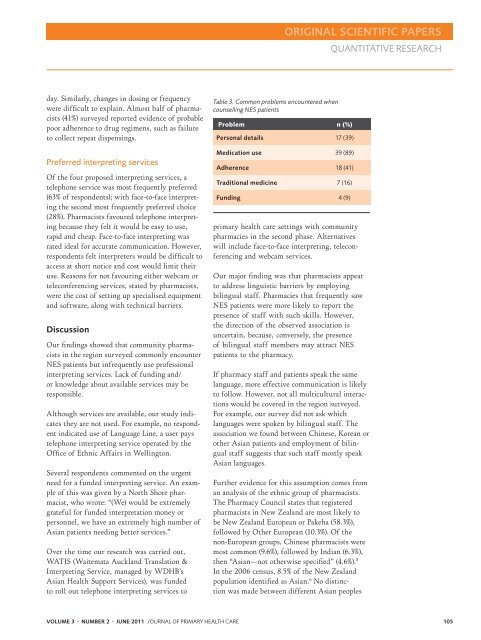single PDF of the entire issue - The Royal New Zealand College of ...
single PDF of the entire issue - The Royal New Zealand College of ...
single PDF of the entire issue - The Royal New Zealand College of ...
You also want an ePaper? Increase the reach of your titles
YUMPU automatically turns print PDFs into web optimized ePapers that Google loves.
ORIGINAL SCIENTIFIC PAPERS<br />
quantitative research<br />
day. Similarly, changes in dosing or frequency<br />
were difficult to explain. Almost half <strong>of</strong> pharmacists<br />
(41%) surveyed reported evidence <strong>of</strong> probable<br />
poor adherence to drug regimens, such as failure<br />
to collect repeat dispensings.<br />
Preferred interpreting services<br />
Of <strong>the</strong> four proposed interpreting services, a<br />
telephone service was most frequently preferred<br />
(63% <strong>of</strong> respondents); with face-to-face interpreting<br />
<strong>the</strong> second most frequently preferred choice<br />
(28%). Pharmacists favoured telephone interpreting<br />
because <strong>the</strong>y felt it would be easy to use,<br />
rapid and cheap. Face-to-face interpreting was<br />
rated ideal for accurate communication. However,<br />
respondents felt interpreters would be difficult to<br />
access at short notice and cost would limit <strong>the</strong>ir<br />
use. Reasons for not favouring ei<strong>the</strong>r webcam or<br />
teleconferencing services, stated by pharmacists,<br />
were <strong>the</strong> cost <strong>of</strong> setting up specialised equipment<br />
and s<strong>of</strong>tware, along with technical barriers.<br />
Discussion<br />
Our findings showed that community pharmacists<br />
in <strong>the</strong> region surveyed commonly encounter<br />
NES patients but infrequently use pr<strong>of</strong>essional<br />
interpreting services. Lack <strong>of</strong> funding and/<br />
or knowledge about available services may be<br />
responsible.<br />
Although services are available, our study indicates<br />
<strong>the</strong>y are not used. For example, no respondent<br />
indicated use <strong>of</strong> Language Line, a user pays<br />
telephone interpreting service operated by <strong>the</strong><br />
Office <strong>of</strong> Ethnic Affairs in Wellington.<br />
Several respondents commented on <strong>the</strong> urgent<br />
need for a funded interpreting service. An example<br />
<strong>of</strong> this was given by a North Shore pharmacist,<br />
who wrote: “(We) would be extremely<br />
grateful for funded interpretation money or<br />
personnel, we have an extremely high number <strong>of</strong><br />
Asian patients needing better services.”<br />
Over <strong>the</strong> time our research was carried out,<br />
WATIS (Waitemata Auckland Translation &<br />
Interpreting Service, managed by WDHB’s<br />
Asian Health Support Services), was funded<br />
to roll out telephone interpreting services to<br />
Table 3. Common problems encountered when<br />
counselling NES patients<br />
Problem n (%)<br />
Personal details 17 (39)<br />
Medication use 39 (89)<br />
Adherence 18 (41)<br />
Traditional medicine 7 (16)<br />
Funding 4 (9)<br />
primary health care settings with community<br />
pharmacies in <strong>the</strong> second phase. Alternatives<br />
will include face-to-face interpreting, teleconferencing<br />
and webcam services.<br />
Our major finding was that pharmacists appear<br />
to address linguistic barriers by employing<br />
bilingual staff. Pharmacies that frequently saw<br />
NES patients were more likely to report <strong>the</strong><br />
presence <strong>of</strong> staff with such skills. However,<br />
<strong>the</strong> direction <strong>of</strong> <strong>the</strong> observed association is<br />
uncertain, because, conversely, <strong>the</strong> presence<br />
<strong>of</strong> bilingual staff members may attract NES<br />
patients to <strong>the</strong> pharmacy.<br />
If pharmacy staff and patients speak <strong>the</strong> same<br />
language, more effective communication is likely<br />
to follow. However, not all multicultural interactions<br />
would be covered in <strong>the</strong> region surveyed.<br />
For example, our survey did not ask which<br />
languages were spoken by bilingual staff. <strong>The</strong><br />
association we found between Chinese, Korean or<br />
o<strong>the</strong>r Asian patients and employment <strong>of</strong> bilingual<br />
staff suggests that such staff mostly speak<br />
Asian languages.<br />
Fur<strong>the</strong>r evidence for this assumption comes from<br />
an analysis <strong>of</strong> <strong>the</strong> ethnic group <strong>of</strong> pharmacists.<br />
<strong>The</strong> Pharmacy Council states that registered<br />
pharmacists in <strong>New</strong> <strong>Zealand</strong> are most likely to<br />
be <strong>New</strong> <strong>Zealand</strong> European or Pakeha (58.3%),<br />
followed by O<strong>the</strong>r European (10.3%). Of <strong>the</strong><br />
non-European groups, Chinese pharmacists were<br />
most common (9.6%), followed by Indian (6.3%),<br />
<strong>the</strong>n “Asian—not o<strong>the</strong>rwise specified” (4.6%). 8<br />
In <strong>the</strong> 2006 census, 8.5% <strong>of</strong> <strong>the</strong> <strong>New</strong> <strong>Zealand</strong><br />
population identified as Asian. 6 No distinction<br />
was made between different Asian peoples<br />
VOLUME 3 • NUMBER 2 • JUNE 2011 J OURNAL OF PRIMARY HEALTH CARE 105

















